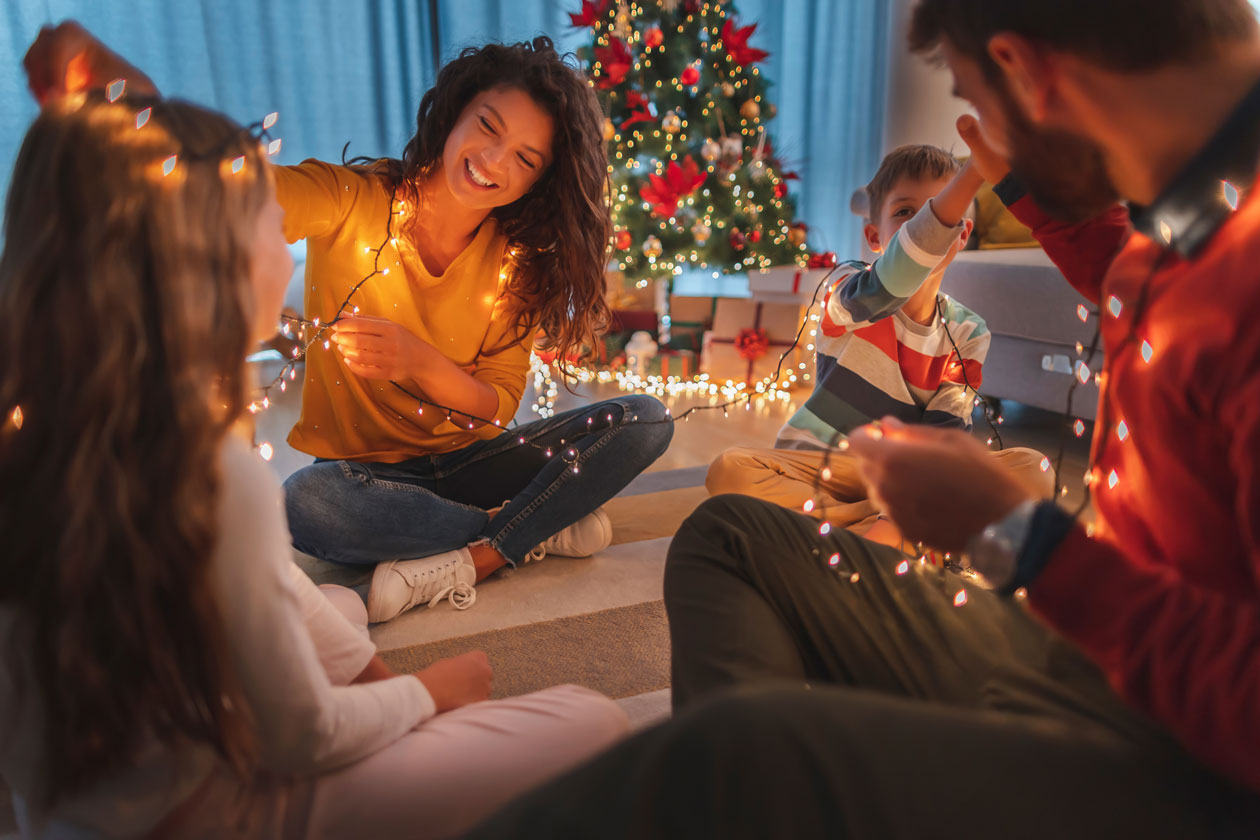Thanksgiving is still weeks away, but holiday decorations have already arrived at stores everywhere. While decorating the home for the holidays elevates the festive spirit, string lights, candles, and even Christmas trees pose a safety hazard.
Before pulling bins of decorations out of storage and enveloping the house’s exterior in festive lights, learn how to stay safe when preparing the home for the season’s celebrations. Follow these holiday decorating safety tips and deck the halls without worry.

Table of Contents:
- Fireplace Safety Tips and Fire Prevention
- Christmas Tree Safety Guidelines
- Holiday Light Installation Safety
- Tips for Candle Safety
- Learn about Poisonous Holiday Plants
Key Takeaways:
Holiday traditions like decorating the home and the tree elevate the festive spirit of the season. Installing holiday light decorations in the home can lead to dangerous falls, and candles and fireplaces pose fire risks. Follow safety best practices to ensure the holidays stay merry and bright.
Fireplace Safety Tips and Fire Prevention
The glow of the fireplace creates a warm and cozy ambiance. During the cold winter months, a fireplace warms the home and adds to the season’s festive mood. Many families hang stockings by the fireplace as part of their Christmas decorating tradition.
While a glowing fire offers warmth and holiday coziness, an unattended fireplace is a safety hazard. According to the National Fire Protection Association, chimneys and fireplaces accounted for 22 percent of the total property damage caused by home fires. Statistics also show that house fires from the fireplace contributed to six percent of all civilian fire deaths. In total, seven percent of all house fires were attributed to the chimney or fireplace.
Be safe when warming a room with a fireplace. Follow these five fireplace safety tips:
Never leave a fireplace unattended. Burning embers emit from the fireplace, and these small hot embers can ignite clothing, carpets, or other items in the home.
Keep the area in front of the fireplace clear. While embers can fly out of the fireplace, keeping flammable items away from the fireplace helps reduce the risk of a fire.
Schedule a fireplace maintenance appointment before using the fireplace for the season. A professional should inspect the fireplace, chimney, and flue. Don’t skip this appointment!
Never ignite a fire using gasoline or other chemicals. Only use untreated wood to feed a fire.
Extinguish the fire completely after using the fireplace. Every ember should be extinguished!
Tree Tips for Safe Holiday Decorating
Live and faux Christmas trees are flammable. However, only real trees dry out over time. Proper hydration is necessary for maximum longevity when choosing a real tree for the holiday. A tree that lacks hydration will dry out and wilt. The dry limbs and needles can more easily ignite; the tree doesn’t need to be near a fireplace or candle to pose a fire hazard. Even the small holiday string lights burn hot, potentially igniting dry needles and branches.
Here are five tree decorating tips to reduce fire risk and increase personal safety.
- Keep real trees hydrated. Real trees dry out, and dry limbs and needles pose a fire risk.
- Position the tree in the home away from candles and the fireplace.
- Glass ornaments can cut and injure small children. Place breakable ornaments at the top of the tree and out of reach of small hands.
- Choose fake trees that are fire-resistant (this will be noted on the box)
- Never place outdoor lights on a tree. Outdoor lights and indoor lights cannot be used interchangeably.
Home Holiday Light Shows: How to Install Holiday Lights Safely
Some homeowners love decorating the home’s exterior in elaborate light designs for the holidays. These lights can sync to music or design an elaborate yard display. Large light shows or displays could take several weeks to complete.
Whether homeowners are stringing only a few strands of lights across their porch or designing a magnificent festive-themed light display, installing the lights could lead to disaster if they are not careful. Homeowners typically need a ladder to string lights on their homes; these intricate installations are not always safe for individuals to tackle on their own.
Individuals who want to transform their home into a twinkling winter wonderland of lights should be mindful that decorations need to abide by some common and a few uncommon safety precautions.
- Always keep three points of contact on the ladder. This means two hands and one foot, or two feet and one hand. Three points of contact ensure proper balance and allow the individual to self-correct if they slip. Don’t hold onto the sides of the ladder; use the rungs for stability.
- Have another person involved in the installation. Always have a buddy system for big projects that could result in injury.
- Don’t overload circuits. Be mindful of how lights are installed related to outlet capacity. Using powerstrips is fine, but never plug power cords into powerstrips. In addition, do not daisy chain–this means plugging one power strip into another power strip.
- Check HOA bylaws before installing elaborate light displays. Some HOAs restrict lawn decorations and displays.
- Turn off lights when leaving the home. Some homeowners use a timer to control their lights, ensuring they are not left illuminated.
Blow Out Fire Hazards and Follow Simple Tips for Candle Safety
Menorahs are the main decor for Hanukkah, and Kwanzaa and Christmas celebrations also involve festive candles. Many Christians light Advent candles during the weeks leading up to Christmas Day. The seven candles of Kwanzaa–known as the mishumaa saba–denote the Seven Principles.
Candles are an important part of religious and holiday celebrations, but these small flickers of flames pose a fire hazard. Before lighting the Menorah, the mishumaa saba, or Advent candles, abide by these safety tips:
- Never leave lit candles unattended.
- Do not place candles around any flammable or combustible items or chemicals.
- Use a tray or decorative plate (or platter) to capture dripping wax. Do not let children play with hot wax.
- Trim the wick.
- Fully extinguish candles with a candle snuffer (look at the wick to ensure it is extinguished).
Learn about Poisonous Holiday Plants
Parents (including pet parents) do not want to spend the holidays in an emergency room because of accidental poisoning. However, many festive and beautiful holiday plants used to decorate the home and add festivity are toxic to humans and pets. Some plants might even cause a fatal reaction.
Families with pets or small children should avoid purchasing toxic holiday plant species to be completely safe. There are two holiday plants to avoid because of poisoning concerns:
- Mistletoe (buy fake for safe kisses)
- Holly (berries are poisonous to pets and people)
These plants are poisonous to humans and pets, but there are many more plant species that are toxic to pets. Purina includes a list of plants that could lead to an animal emergency; top offenders include holly and mistletoe and poinsettias, lilies, and azaleas. Just say no to these flowers and plants for a pet-friendly holiday.
Stay Safe this Holiday Season
Families will begin preparing for the next major winter holidays as the weeks approach Thanksgiving. Holiday decor adds to the fun and spirit of the season. Following proper safety protocols decreases the risk of home fires and can help keep families out of the ambulance and emergency room during the holiday season.

